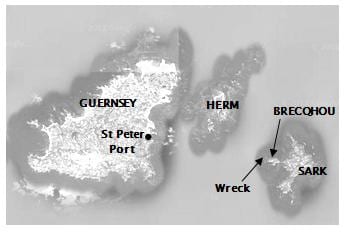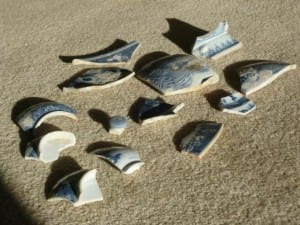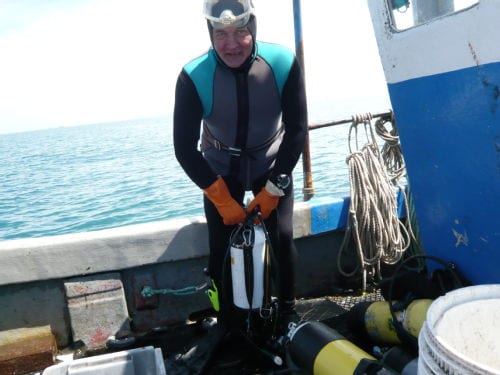As the fate of both the Valentine and the Abergavenny attests, shipwreck was a frequent occurrence in the history of the EIC in the Georgian era. Of the 980 EIC voyages between 1747-88, and discounting those ships which were to remain abroad, less than 94% returned home: 39 were wrecked or ‘lost’, 7 were burnt and 12 were captured. By far the worst year was 1779/80 when six ships were captured and two were lost out of 26 which sailed. It was for this reason that ships were owned by a number of investors, and it seems Raymond had a group of associates who worked together in partnership. Cargos from shipwrecked vessels provide historians with a ghostly counterfoil to pristine collections of Asian luxuries assembled in many surviving stately homes in Britain, offering a unique, ‘immaterial’ perspective on the Company’s domestic material culture.
Nearly 200 years after the Valentine was wrecked, a young Guernsey diver, Richard Keen (see image above), decided to try and find the wreck. Richard was born and brought up in an old farmhouse in Guernsey (Channel Isles) where his father grew roses. It was expected he would join his father when he left school, but his life changed when he tried out the new sport of scuba diving while in his mid-teens. On leaving school he took up a career diving for shellfish. While looking for scallops he found many objects on the sea bed and his enquiring mind led him to an interest in marine archaeology.
Richard has discovered over 30 wrecks on the rocks and reefs in Guernsey waters, some by accident and others while un-snagging crab pots and trawl nets. He started to research these wrecks, and others which had been recorded in old newspapers and diaries but had never been located. His most important archaeological find was that of a Roman wreck, known as ‘Asterix’ which he discovered in the harbour mouth at St Peter Port in 1982.
 Some years before this Richard came across a map in the Priaulx Library at St. Peter Port which houses some of the island’s archives. This is dated 1816 and shows a rock off the island of Brecqhou (close to Sark) with the words ‘Le Neste upon which the Valentine Indiaman was wrecked in 1779’. He became fascinated by the idea of finding the wreck but the very high rise and fall of the tide and strong currents, with many rocks in the area, make this a hazardous place in which to dive. However, Richard dived and successfully located the site in 1974. Others attempted to dive on the wreck the following year but their attempt was aborted. Eventually some pieces of lead, red dyewood, agate and pottery were retrieved and were declared to the Receiver of Wrecks.
Some years before this Richard came across a map in the Priaulx Library at St. Peter Port which houses some of the island’s archives. This is dated 1816 and shows a rock off the island of Brecqhou (close to Sark) with the words ‘Le Neste upon which the Valentine Indiaman was wrecked in 1779’. He became fascinated by the idea of finding the wreck but the very high rise and fall of the tide and strong currents, with many rocks in the area, make this a hazardous place in which to dive. However, Richard dived and successfully located the site in 1974. Others attempted to dive on the wreck the following year but their attempt was aborted. Eventually some pieces of lead, red dyewood, agate and pottery were retrieved and were declared to the Receiver of Wrecks.
On 9 January 1976 Richard gave a lecture to everyone interested in the wreck and as a result the ‘Valentines Excavation Group 1976’ was established to undertake a coordinated survey of the wreck site, near a rock called ‘Le Neste’ off the western tip of Brecqhou (to view the 1976 report click here). Dives were made on ten days, starting on 10 April with the last on 12 December. The seabed in the area comprises a mass of rocky gullies with gravel in the bottom, and with kelp growing on the rocks. Work on the site was only possible during neap tides and then only close to slack water, due to the strong currents. However the depth of the remains at diving time is between 10 to 18 metres, so the divers did not have any problems with decompression.

Richard Keen with richly coloured red dyewood (to left). Even after being in the sea for two-hundred years the red colour is vibrant when the wood is cut and it can still be used to dye fabric.
The main cargo of the vessel was salt petre which was much in demand for the manufacture of gun powder, a substance which would have dissolved in the sea. Another significant part of the cargo was red dyewood which was dunnage as well as being of value for dyeing. Large logs of dyewood were found as this is extremely hard wood. The timbers of the ship decomposed long ago although some canons remain to mark the site where the Valentine foundered. One interesting find was a broken anchor (which had been mentioned in the captain’s journal) with a cannon strapped to it. This illustrates the desperate attempts made by the crew to save their ship in 1779.

The finer shards illustrated right from a good quality (sugar?) bowl, decorated inside. The blue and white china was a popular design in England.
Since 1976 other dives have been held and a number of local people have retrieved items from the wreck site. Shards of blue and white Chinese porcelain are often found. It was made in China, loaded in Canton and either brought directly to England or taken to India by one of the many EIC ‘country ships’ used by the Company to transport their cargo in Asian waters. Porcelain was often packed in boxes with loose tea or pepper for padding, and best use of space. The Valentine had only visited India on her last voyage, but her cargo consisted of a range of Chinese porcelain from best quality items for the aristocratic tea party to thicker items for general use.

Many small pieces of agate were discovered, mostly orange or rust in colour. They were cut and roughly shaped square or rectangular in India to be made into signet rings and broaches in England. Agate is an extremely hard stone and it is remarkable that these pieces were smoothed and bevelled by India craftsmen without modern technology. Their loading was not noted in the captain’s journal so it is likely they were private trade.

Other items retrieved illustrate life on board ship: metal handles from furniture or travelling luggage (shown right), and ground glass stoppers for decanters or medical jars . They may have been for items used on the voyage – although there was a significant quantity found, which may suggest they were also part of the private trade.
Broken bottles were also found. They may have been loaded in Madeira and would have contained fortified or non-fortified wine. Madeira wine was collected on the outward journey and some of it was required for EIC staff in India. Apparently, the voyage improved the quality, if it wasn’t drunk by officers and passengers before they got back to England! As already stated, quantities of redwood have also been salvaged. Even after being in the sea for 200 years the red colour is vibrant when the wood is cut, and it can still be used to dye fabric.
Previous / Return to Valentines Mansion Case Study Home Page
